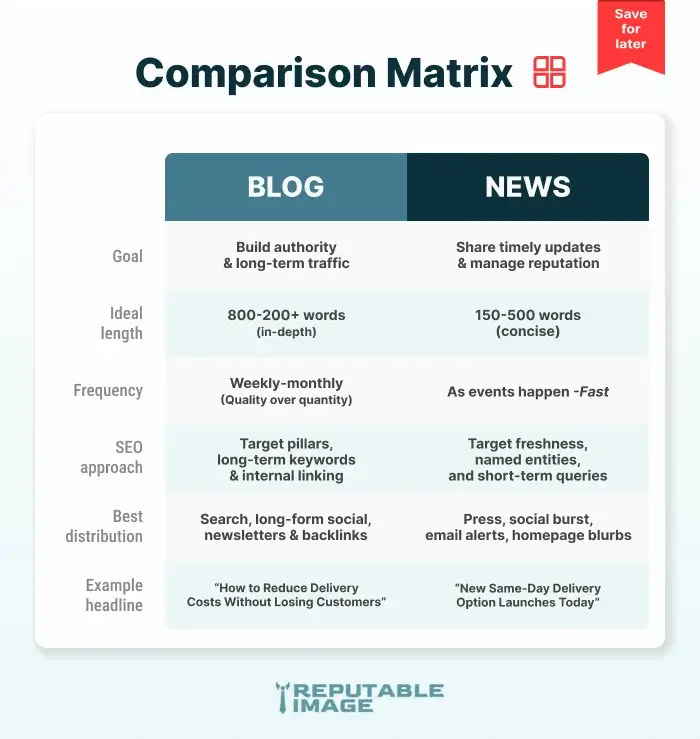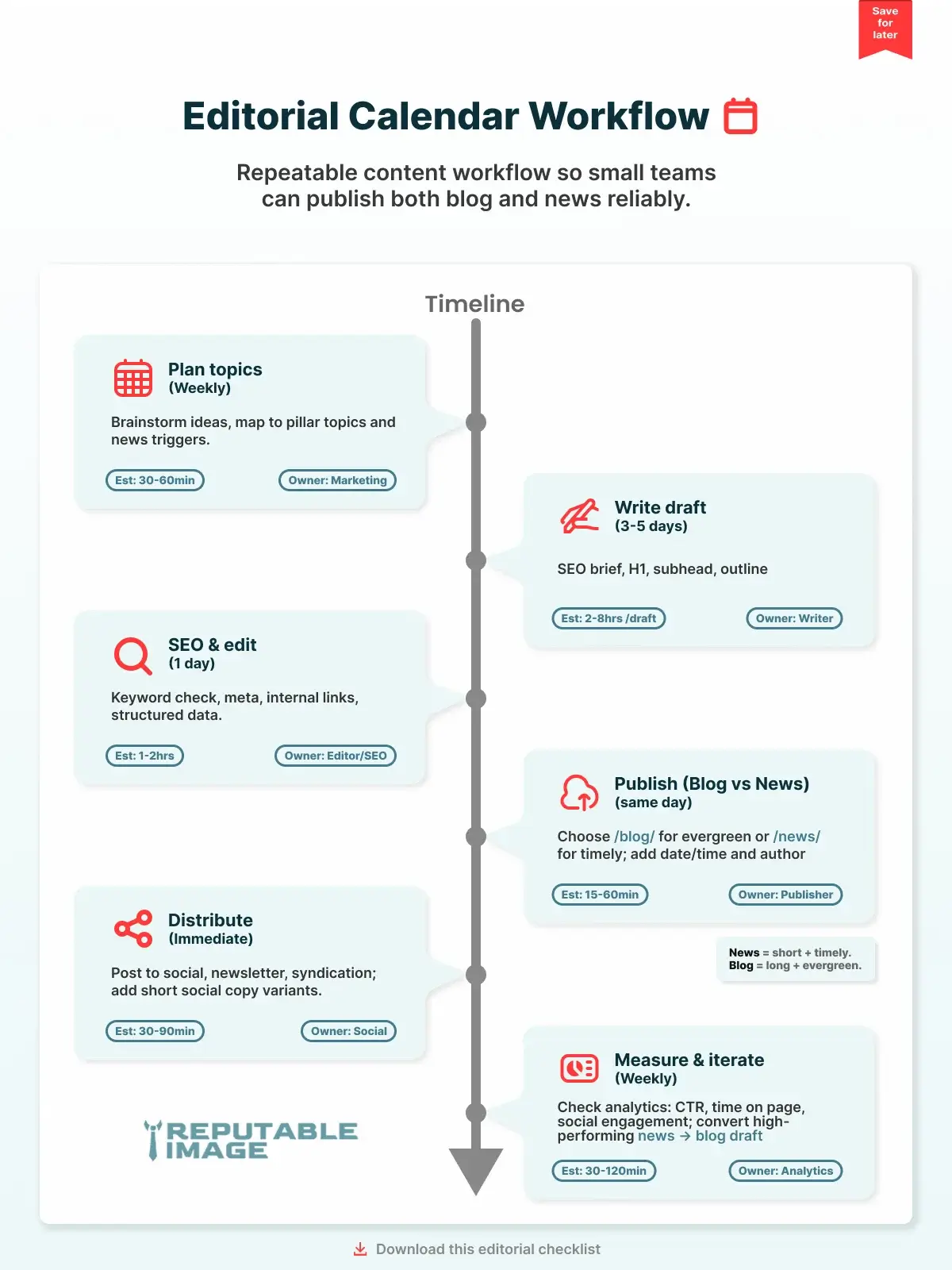
Integrating Blog and News Sections
for Content Marketing
Integrating blogs and news sections for content marketing gives small businesses the best of both worlds: long-lived, search-friendly content that grows organic traffic and a nimble channel for timely announcements. A smart structure makes each section do what it does best — the blog builds authority and SEO over months, while the news section captures events, offers, and urgent updates that keep your audience informed and your site fresh. Together they reduce risk (fewer “dead” pages), increase discoverability, and create repeatable processes for content creation.
Why Combine Blog and News
(Instead of One or the Other)?
Blogs and news pages serve different buyer needs. Evergreen blog posts answer discoverable, high-intent questions (how-tos, guides, local “best of” content) and can compound in value for months or years. News pages handle time-sensitive items — product launches, service changes, press mentions — and signal freshness to search engines and customers. When integrated, a news item can become the seed for a future, longer-form blog post once the topic proves interest. HubSpot notes that blogs continue driving traffic long after publication; a news-friendly site simply amplifies that effect when paired with a plan. (HubSpot)
Structural Decisions
That Matter
Keep the URL structure simple and intentional: use /blog/ for evergreen posts and /news/ (or /updates/) for time-sensitive items. Avoid mixing by date only — a clear folder helps users and search engines understand intent. Each news item should include publication date and an author or editor note; blogs should prioritize pillar pages, internal links, and comprehensive on-page SEO. Use categories and tags carefully to avoid duplicate content and keep navigation intuitive.
Editorial Process
& Newsroom Thinking
Adopt a mini-newsroom workflow for cadence and quality:
idea → brief → draft → SEO check → publish → promote → measure.
The Content Marketing Institute’s newsroom approach scales this model — it helps small teams produce timely pieces without sacrificing quality or strategy. Assign roles (owner, writer, editor, publisher), define SLA timelines for news items (e.g., publish within 24–48 hours of an event), and hold weekly editorial triage so urgent items don’t derail
larger content goals.
(Content
Marketing Institute
)
Because templates are pre-built, they shorten time-to-market and make iterative changes easier; you can focus on content and offers rather than layout engineering. This advantage improves short-term cashflow and reduces opportunity cost for founders.
SEO Best Practices
for Both Sections
For SEO, treat blogs and news as sister channels. Use structured data where appropriate (Article, NewsArticle, BreadcrumbList), submit updated XML sitemaps after batch publishes, and avoid publishing headline-only pages that add no value. Freshness matters for timely queries: search engines prefer up-to-date content on rapidly changing topics, but frequency alone won’t replace depth — use the news section to capture immediate interest, then expand top stories into blog posts for long-term ranking benefits. SEMrush and industry guides note the importance of “fresh content” balanced with authority and depth. (Semrush)
Content Types
and Distribution Strategy
Reserve your blog for in-depth how-tos, case studies, and pillar content that targets evergreen queries. Use the news section for announcements, company updates, event recaps, and short industry reactions. Amplify both via social, newsletters, and a “Latest updates” site module. Syndicate news short-form to social and email quickly; save blog promotion for richer channels like long-form social posts, guest articles, or downloadable PDFs. Visual assets (infographics, charts) created for blog posts are also excellent social magnets and fit naturally into news blurbs when abbreviated. Pair publishing with distribution best practices — see 6 Strategies for Social Media Integration.
UX & Technical Considerations
Make the difference visible in UI: label sections clearly, show published dates, and add “updated” timestamps for refreshed blog posts. A good CMS enables moving a news thread into a blog draft without losing metadata. Prioritize performance: news items can increase crawl frequency, so keep templates lean and use lazy-loading for images. Keep an accessible archive and add an events or press filter so visitors and journalists can find relevant historical items quickly.
Metrics to Measure Success
Track both short- and long-term indicators: news engagement (impressions, social shares, immediate CTR), and blog ROI (organic sessions, backlinks, conversions per post). Monitor which news topics later turn into high-performing blog posts — that repeatable pattern should drive your editorial calendar. Use analytics to create topic clusters: when a news item shows sustained interest, expand it into a pillar blog to capture long-tail SEO value. Use those metrics to refine your site and content — learn how in Using Analytics to Improve UX.
Common Pain Points
and How Integration Fixes Them
-
Pain: stale homepage and no story cadence.
Fix: a news stream gives the homepage a reason to refresh. -
Pain: short-term PR wins that disappear.
Fix: convert news items into deeper blog posts to preserve value. -
Pain: scattered publishing processes.
Fix: a newsroom workflow centralizes responsibilities and speeds approvals.
Overall, integrated workflows reduce wasted effort and turn one-off announcements into compound-performing content.
Long-term Benefits for Small Businesses
Over time, an integrated approach lowers acquisition cost by growing organic traffic and improving conversion paths, shortens crisis response time with a ready publishing channel, and strengthens brand trust through consistent, timely communication. The strategy compounds: each blog post builds topical authority while news items keep the brand relevant and responsive.

Conclusion: Taylored Expert Help
At Reputable Image, we design user-centered content systems: clean blog + news templates, editorial calendars, SEO-ready metadata, and custom visuals that match your brand. We also offer copywriting, social distribution, analytics setup, and maintenance — everything you need to turn short bursts of news into long-term traffic. Contact us or Call one of our representatives and we’ll audit your content flows and deliver a 3-step plan to integrate your blog and news sections effectively.
Sources:
1. Zoe Ashbridge at HubSpot - "What’s a Blog (& Why I’d Consider Starting One)"
https://blog.hubspot.com/marketing/what-is-a-blog
2. Andrea Fryrear at Content Marketing Institute - "How a Newsroom Approach Helps Teams Produce Quality Content on a Deadline"
https://contentmarketinginstitute.com/content-marketing-strategy/how-a-newsroom-approach-helps-teams-produce-quality-content-on-a-deadline
3. Ravi Pandya at Semrush - "What Is Fresh Content & Is It Important for Your Site?"
https://semrush.com/blog/fresh-content


